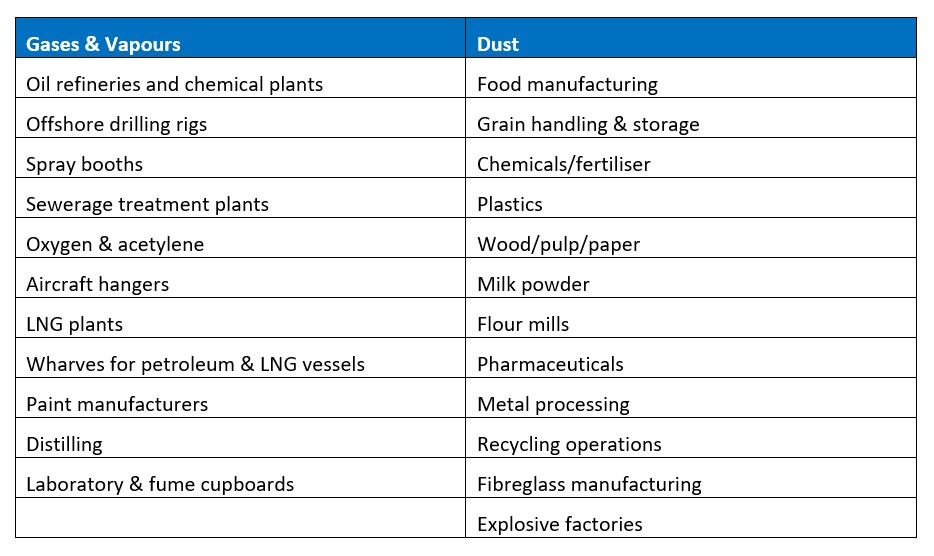7 Simple Techniques For Roar Solutions
7 Simple Techniques For Roar Solutions
Blog Article
Rumored Buzz on Roar Solutions
Table of ContentsRoar Solutions - An OverviewThe Single Strategy To Use For Roar SolutionsAn Unbiased View of Roar Solutions
In order to safeguard setups from a potential explosion a method of evaluating and classifying a potentially unsafe area is required. The objective of this is to guarantee the appropriate selection and setup of tools to ultimately prevent an explosion and to make certain security of life.
(https://padlet.com/thomascarrillo4740/roar-training-solutions-jrrziydpbb7m3xsa)
No equipment must be set up where the surface temperature of the devices is above the ignition temperature level of the provided risk. Below are some typical dirt unsafe and their minimal ignition temperature. Coal Dust 380C 225C Polythene 420C (thaws) Methyl Cellulose 420C 320C Starch 460C 435C Flour 490C 340C Sugar 490C 460C Grain Dust 510C 300C Phenolic Resin 530C > 450C Aluminium 590C > 450C PVC 700C > 450C Soot 810C 570C The possibility of the threat being present in a focus high adequate to create an ignition will certainly vary from place to area.
In order to classify this danger a setup is divided right into areas of risk relying on the quantity of time the harmful is present. These locations are described as Zones. For gases and vapours and dirts and fibres there are three areas. Area 0 Area 20 A hazardous ambience is very likely to be existing and may be existing for extended periods of time (> 1000 hours annually) or perhaps continuously Zone 1 Area 21 A hazardous atmosphere is feasible yet unlikely to be existing for extended periods of time (> 10 450 C [842 F] A category of T6 means the minimal ignition temperature level is > 85 C [185 F] Hazardous area electric equipment maybe made for usage in greater ambient temperatures. This would showed on the ranking plate e.g. EExe II C T3 Ta + 60C( This suggests at 60C ambient T3 will not be surpassed) T1 T1, T2, T3, T4, T5, T6 T2 T2, T3, T4, T5, T6 T3 T3, T4, T5, T6 T4 T4, T5, T6 T5 T5, T6 T6 T6 A T Class ranking of T1 suggests the optimum surface temperature level produced by the tool at 40 C is 450 C. Assuming the associated T Course and Temperature rating for the tools are proper for the location, you can always make use of a tool with a more strict Division score than needed for the location. There isn't a clear solution to this question. It actually does rely on the type of tools and what fixings need to be lugged out. Devices with details test procedures that can't be carried out in the field in order to achieve/maintain 3rd party rating. Need to come back to the manufacturing facility if it is prior to the devices's service. Field Fixing By Authorised Employee: Complicated testing might not be needed nonetheless particular treatments might need to be adhered to in order for the devices to maintain its 3rd celebration ranking. Authorised employees must be used to do the work correctly Fixing need to be a like for like replacement. New component must be taken into consideration as a straight replacement needing no unique screening of the devices after the repair is full. Each tool with a hazardous score must be reviewed separately. These are outlined at a high level below, however, for more thorough information, please refer directly to the guidelines.
The Single Strategy To Use For Roar Solutions
The devices register is a detailed database of devices records that includes a minimum collection of areas to recognize each thing's place, technological criteria, Ex classification, age, and ecological data. The proportion of Thorough to Shut inspections will be determined by the Equipment Danger, which is assessed based on ignition threat (the likelihood of a source of ignition versus the possibility of a flammable ambience )and the hazardous area classification
( Zone 0Area 1, or 2). Implementing a robust Risk-Based Assessment( RBI )approach is critical for making sure compliance and safety and security in taking care of Electric Equipment in Hazardous Areas( EEHA).
Getting My Roar Solutions To Work

In regards to eruptive danger, a dangerous location is an environment in which an eruptive atmosphere is existing (or might be anticipated to be present) in quantities that require unique precautions for the construction, installment and use tools. Roar Training Solutions. In this post we check out the difficulties dealt with in the office, the danger control actions, and the called for proficiencies to work safely
It is a consequence of contemporary life that we produce, save or manage a range of gases or liquids that are deemed combustible, and a variety of dusts that are considered combustible. These substances can, in particular conditions, form explosive environments and these can have significant and tragic effects. Most of us are familiar with the fire triangular remove any among the three elements and the fire can not occur, but what does this mean in the context of dangerous locations? When damaging this down into its simplest terms it is basically: a mix of a particular amount of release or leak of a specific material or product, mixing with ambient oxygen, and the existence of a source of ignition.
In most instances, we can do little regarding the levels of oxygen in the air, yet we can have considerable influence on sources of ignition, as an example electrical tools. Unsafe areas are recorded on the harmful location classification drawing and are determined on-site by the triangular "EX LOVER" indicator. Here, among other vital info, areas are divided right into three types relying on the risk, the likelihood and period that an eruptive atmosphere will exist; Zone 0 or 20 is regarded one of the most harmful and Area 2 or 22 is considered the least.
Report this page